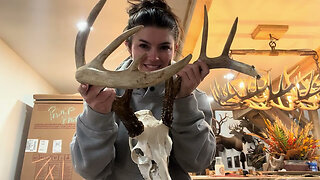Premium Only Content

Antique Chest or Repro? How to tell the difference? (Antiques Road Trip)
I’m David Harper (BBC Bargain Hunt / Antiques Road Trip) and I’m going to show you how to tell the difference between an antique chest of drawers and a reproduction
This is a genuine antique Chest of drawers. A small, pretty version and made around 1880. I know this, but I’m go to show you can know it too…and therefore how you can spot a real antique chest of drawers from a fake reproduction
Let’s start with Colour, condition and patination…It’s aged beautifully, there are patches of discolouration where the polish has reacted to heat or sunlight maybe.
There are small areas of damage if you look closely , missing sections of veneer…and fascinatingly you can see the colour of the wood underneath the veneer. The wood underneath when new would have been very white and crisp, but over the years the white colour has mellowed down…in some areas it’s been touched in …this is a good sign and to be expected. Antique pieces of furniture need to show wear, it’s a good thing…some things , like some people…just get better with age!!
Theres a little splitting in the veneer in places…little cracks here and there. Here’s a good example on this drawer.
Not that noticeable, but a good sign…possibly even caused from over eager closing and locking of the panel.
And Talking about the panel, EXAMINE ITS COLOUR facing you… it’s a nice patination , matches everything else in view…but open the panel and what do you notice on the back…the colour is very different…very different
And This, is very good news. what you’re looking at now was pretty much the chests original colour 14o years ago…but over the last century and a half, the colour on the front has changed with use, polish…light…a good bit of grime, grease from fingers and dust …all rubbed in and all over, has , over time altered the original colour…it’s just what you want to see. Whereas the area prettier Ted from the world has kept its original colour… isn’t that marvellous!
Now what about the drawers,,,the drawers will every time reveal secrets, I promise you
Always take a drawer completely out and look at its construction …ooh, the giveaway dovetail joints. Here you’ll see evidence of hand cutting. See this line here. It’s a scribe mark drawn by the cabinet maker as a measure. He’d cut the dovetail to the line. The tails are also very fine and not perfectly matched…well, they wouldn’t be, they’re hand cut! A sign of an antique
A sign of a reproduction would be chunky dovetails, all the same size, crude amd with no measuring line here…because of course it wouldn’t be needed….it would be mass machine made
Now take a look at the bottom of the drawer. The base. See how all the way around the edge, the wood is shaved off…chamfered.
This is done so the panel fits snuggly into the drawer…and it’s done beautifully…and by hand…you can tell this because of this uneven wavy line, indicating the hand of a craftsman
Before we put the drawer back in, Take a look at the back of the handles…are they original? You can tell straight away. Look for evidence of old handles being in place. Obvious Holes, stains, imprints of other shaped handle backs…This of course tells you whether the handles have been replaced, but also shows that the piece is likely antique…as it was quite normal to periodically replace handles after damaged coursed by use, or to update the piece as fashions changed.
In this case, theres no evidence of a handle change, which is really rather good, the handles are original
Sticking with the handles for a moment…you’ll also notice if you study the shape and form of them, that the turning is very slightly different. The handles are not perfectly matched when scrutinised…again, a lovely sign of hand workmanship, which you dont find on mass made reproductions…
Finally the bottom…you know that the bottom of any antique can tell you so much…and this is no exception
First notice the dark colour of the base board. Very good, that’s nicely aged…but look around the skirt - this is the area that sits on a surface…in this case, a table or a desk. You can see the wear here made over years as the chest is shimmied around
Thanks for watching. Do let me know if this was useful
#davidharper #antiques #antiquesroadtrip #bargainhunt #antiquechest #antiquechestofdrawers #antiquefurniture #howtobeanantiquesdealer
-
 10:04
10:04
Space Ice
2 hours agoThe Movie Silent Hill Is Like Resident Evil Without The Good Parts - Worst Movie Ever
14.1K4 -
 5:49
5:49
Hannah Barron
23 hours agoRedneck Euro Mount
12.8K19 -
 32:34
32:34
hickok45
7 hours agoSunday Shoot-a-Round # 268
8.81K8 -
 27:33
27:33
The Finance Hub
17 hours ago $6.33 earnedBREAKING: ALINA HABBA JUST DROPPED A MASSIVE BOMBSHELL!!!
28.6K58 -
 40:23
40:23
PMG
22 hours ago $0.62 earnedHannah Faulkner and Dr. Michael Schwartz | EXPOSING BIG PHARMA
16.2K1 -
 18:55
18:55
GBGunsRumble
19 hours agoGBGuns Range Report & Channel Update 15FEB25
11.5K -
 13:31:32
13:31:32
iViperKing
20 hours agoGood Times + Good Energy Ft. Whez.. #VKGFAM #RRR
99.2K13 -
 12:24
12:24
Winston Marshall
1 day agoWOAH! Bannon just Revealed THIS About MUSK - The Tech-Right vs MAGA Right Civil War Ramps Up
225K309 -
 7:33:46
7:33:46
Phyxicx
19 hours agoRaid & Rant with the FF14 Guild on Rumble! Halo Night just wrapped up! - Go Follow all these great guys please! - 2/15/2025
151K4 -
 10:42:19
10:42:19
Reolock
21 hours agoWoW Classic Hardcore (LVL 60) | RAID DAY | Rumble FIRST HC Raid
97.3K5